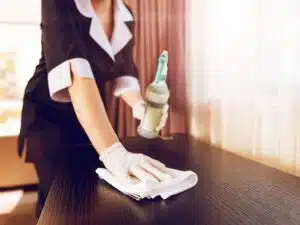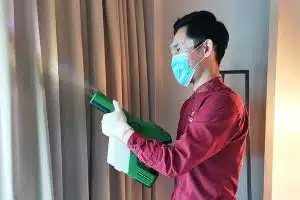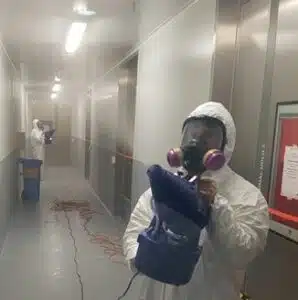As outlined in our previous article, cleanliness is dominating the headlines within the hotel industry, with a number of press releases on new initiatives from all the major chains. The landscape has transformed quickly, to help keep up with the standards this article will summarise the basic principles of cleaning and sanitisation of guest rooms and how that can be achieved quickly, easily and cost-effectively.
Rapidly changing expectations
A recent survey by Forbes about post Covid-19 travel choices highlights that airport and aircraft cleanliness would have more impact on a traveller’s decision to fly than any other factor. This demonstrates how much of a priority cleanliness has become. Which is why hotels must not overlook it. Cleanliness has become one of the most important factors in the road to recovery and in the future. So much so that Craig S. Smith, Group President, Asia Pacific, Marriott International said during a recent webinar that: “Safety and Hygiene have become the new amenity”.
With brands like Hilton, Marriott and many more announcing their new cleanliness protocols, it’s even more imperative to be transparent about new procedures in order to protect customers and retain a competitive edge.
Taking a closer look at ‘cleaning’
There’s an extra step in the cleaning process that all hoteliers should be considering, and that’s disinfecting or sanitising the room.
The words clean, sanitise and disinfect get used interchangeably but they’re not the same:
- Cleaning a surface removes visible debris, dirt and dust
- Sanitizing a surface makes that surface free of visible dirt contaminants which could affect your health. It is meant to reduce the occurrence of bacteria, viruses and fungi
- Disinfecting a surface kills microscopic organisms.
Why you might need to stop the spray and wipe

The majority of hotels will likely use a traditional ‘spray and wipe’ method to sanitise. This is not necessarily the best approach. It’s time-consuming and often the chemical is not left on the surface long enough to be effective (see this New York Times article). There’s also a cross-contamination risk if the same cloths are reused.
Lessons from other industries
So, if we need to adapt the spray and wipe approach, are there lessons to be learned from hospitals and the food production industry, which have a long history of needing to be extremely hygienic?
The methods they use include spraying and wiping with disinfectant, fogging machines in food production and UV-C in hospitals. Then there are electrostatic sprayers – they’re new to the disinfection scene, but this technology has been used in spray painting for many years. All these technologies have come up in announcements from the major hotels. But what is involved and how viable are they as options for guest room cleaning?
UV-C
A number of hotels have announced they will be making use of UV-C for the sanitisation of smartphones and tablets shared by hotel employees. It has been used for decades as a powerful, rapid and chemical-free disinfection method. The UV light emitted deactivates the DNA of viruses, bacteria and fungi, destroying their ability to multiply and cause disease.
There are a few things to consider with UV-C:
- The ‘shadowing’ effect – this is when an object between the light source and the target blocks the UV-C, resulting in shadowed areas
- UV-C can’t reach hidden surfaces
- Long term use can damage finishes, and employees need to be well trained as UV-C can burn skin and permanently damage retinas.

So, whilst you may need to think further about UV-C for guest room disinfection, it’s a practical option for sanitising electronic devices like shared smartphones and tablets, TV remotes and guest room keys. It is also good for air-sanitisation and safe to use in occupied rooms, so could work well for meeting rooms and staff areas.
Electrostatic Sprayers
Electrostatic Sprayers overcome the many of the issues associated with the traditional spray and wipe method; namely time, overuse of the chemical and possible cross-contamination. Electrostatic sprayers provide a quick and easy way to achieve 360 degree, touchless disinfection. How do they work? Remember back to science at school and magnets. Negative and positive stick together, positive and positive repel from each other. Ok.

The electrostatic sprayer charges the disinfectant and makes it positive. Remember positive repels positive so when the disinfectant is shot out of the sprayer, it fans out better as the positive particles try and get away from one another. Not only that, as most surfaces are negatively charged this helps the disinfectant to stick well to the surface. This means that no matter what angle you disinfect a surface from, the disinfectant clings to the entire surface and doesn’t need wiping off (which also stops cross-contamination). Electrostatic sprayers take about 70% less time than conventional spray and wipe, and use 65% less chemical. This is critical as the disinfectants used to address COVID can be extremely expensive.
Fogging
Fogging is traditionally used in large food preparation areas, and involves spraying large areas with a gun-like fogging machine. There are a number of quirks to consider with this method:

The machines leave a shadow when they settle and are not as good for surface wrap around as Electrostatic Sprayers. They also leave a residue that needs to be wiped down afterwards
- You’ll need to invest in PPE, due to the minuscule size of the microns
- Everyone must stay away from the treated area for at least an hour (depending on the chemical)
- You have to go slow so you can get the surface areas wet long enough for the disinfectant to be effective. This generally means that you use more chemical.
Whichever method you use, communication with staff and customers is essential to ensure maximum safety.
Finally, don’t make all this effort without informing your guests. Let them know about all the initiatives you’ve put in place to care for their health and wellbeing. These messages should pop up in your marketing literature, on your website and all of your proposals for meeting and event business.
There’s still a lot of uncertainty about how travel will look in the wake of this global pandemic. But one thing you can be sure of is, that cleanliness will be the top priority hotels.
Stay tuned for part 2 of the article in which we will take a closer look at some of these methods.

